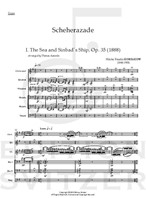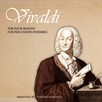
Scheherazade Op. 35
Composer: Nikolai Rimsky-Korsakov
Instrument: Percussion Ensemble
Level: Advanced
Published: 2015
Price: €80.00
Item details
-
Description +
-
Arranged by Thomas Aanonlie
Duration: 50 min.Scheherazade is a symphonic poem composed by Nikolai Rimsky-Korsakov in 1888. Based on One Thousand and One Nights, sometimes known as The Arabian Nights, this orchestral work combines two features typical of Russian music and of Rimsky-Korsakov in particular: dazzling, colorful orchestration and an interest in the East, which figured greatly in the history of Imperial Russia, as well as orientalism in general. It is considered Rimsky-Korsakov's most popular work.
I. The Sea and Sinbad's Ship (Largo e maestoso — Lento — Allegro non troppo — Tranquillo)
Sextet: Glockenspiel, xylophone, vibraphone, marimba I, marimba II and timpani.
II. The Kalendar Prince (Lento — Andantino — Allegro molto — Vivace scherzando — Moderato assai — Allegro molto ed animato)
Octet: Glockenspiel, xylophone, vibraphone, marimba I and II, triangle, cymbals and timpani.
III. The Young Prince and The Young Princess (Andantino quasi allegretto — Pochissimo più mosso — Come prima — Pochissimo più animato)
Ensemble of ten: Glockenspiel, xylophone, vibraphone, marimba I and II, triangle, tambourine, cymbals, snare drum and timpani.
IV. Festival at Baghdad. The Sea. The Ship Breaks against a Cliff Surmounted by a Bronze Horseman. (Allegro molto — Lento — Vivo — Allegro non troppo e maestoso — Tempo come I)
Ensemble of 11: Glockenspiel, xylophone, vibraphone, marimba I and II, snare drum, tambourine, triangle, cymbals, bass drum (and tam-tam), and timpani.
-
-
Instrumentation +
-
Percussion Ensemble:
I. The Sea and Sinbad's Ship (Largo e maestoso — Lento — Allegro non troppo — Tranquillo)
Sextet: Glockenspiel, xylophone, vibraphone, marimba I, marimba II and timpani.
II. The Kalendar Prince (Lento — Andantino — Allegro molto — Vivace scherzando — Moderato assai — Allegro molto ed animato)
Octet: Glockenspiel, xylophone, vibraphone, marimba I and II, triangle, cymbals and timpani.
III. The Young Prince and The Young Princess (Andantino quasi allegretto — Pochissimo più mosso — Come prima — Pochissimo più animato)
Ensemble of ten: Glockenspiel, xylophone, vibraphone, marimba I and II, triangle, tambourine, cymbals, snare drum and timpani.
IV. Festival at Baghdad. The Sea. The Ship Breaks against a Cliff Surmounted by a Bronze Horseman. (Allegro molto — Lento — Vivo — Allegro non troppo e maestoso — Tempo come I)
Ensemble of 11: Glockenspiel, xylophone, vibraphone, marimba I and II, snare drum, tambourine, triangle, cymbals, bass drum (and tam-tam), and timpani.
-
-
About the composer +
-
Nikolai Andreyevich Rimsky-Korsakov (18 March [O.S. 6 March] 1844 – 21 June [O.S. 8 June] 1908) was a Russian composer, and a member of the group of composers known as The Five.[a 2] He was a master of orchestration. His best-known orchestral compositions—Capriccio Espagnol, the Russian Easter Festival Overture, and the symphonic suite Scheherazade—are staples of the classical music repertoire, along with suites and excerpts from some of his 15 operas. Scheherazade is an example of his frequent use of fairy tale and folk subjects.
-
-
Reviews +
-
Review (Percussive Notes, July 2016)
“Scheherazade” is a symphonic tone poem composed in the late 1800s by renowned Russian composer Nikolai Rimsky-Korsakov. This work is one of his most notable and tells the mythical Arabian Nights story in a programmatic musical setting. Thomas Aanonlie’s arrangement or, more accurately, transcription of the orchestra work holds faithfully true to the original to such an extent that, according to the arranger, the drum voices (percussion and timpani) are identical to the original score. If performed in its entirety, it is a nearly 50-minute work for 11 percussionists, but the notes suggest that movements may be performed individually, and one movement uses as few as six players.
A reduction of an orchestral score to five keyboard parts inherently suggests a high level of activity and difficulty. All of the keyboard players are required to perform with three or four mallets in spots, including glockenspiel and xylophone, and anything more than a measure or two of rest is rare in each of the 20-page parts. In addition to the transcribed upper string and woodwind voices that move rapidly around the keyboard and require advanced reading skills and note accuracy, passages such as double-stop sixteenth-notes at Allegro molto will challenge the technical facility and stamina of players. It shouldn’t go without saying that the musical nuance (much of which is meticulously indicated) of rendering this Romantic-era work will also require a professional level of attention. Because the timpani and non-pitched percussion parts are identical to the original score, I’ll refrain from further description of those parts, other than to echo the arranger’s notes that state the “standard of difficulty is high.”
Aanonlie uses the term “gargantuan” to describe the task of arranging this entire work for percussion ensemble. I would use the same to describe the task of performing the work. For a professional or a highly ambitious graduate-level ensemble, this piece would prove challenging. One option may be to program this work with a large university ensemble, allowing students to rotate in and out as successive movements are performed.
—Josh Gottry
-
-
Credits +
-
Front Cover graphics and layout: Gaia Gomes
Translation: Anders Fitje
Engraving: Johan Svitzer
Printed in Copenhagen, Denmark
Copyright © Edition SVITZER
www.editionsvitzer.com
-


